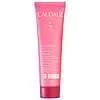What's inside
What's inside
 Key Ingredients
Key Ingredients

 Benefits
Benefits

 Concerns
Concerns

 Ingredients Side-by-side
Ingredients Side-by-side

Water
Skin ConditioningVitis Vinifera Fruit Water
Skin ConditioningDicaprylyl Ether
EmollientGlycerin
HumectantButyrospermum Parkii Butter Extract
Skin ConditioningHexyldecanol
EmollientHexyldecyl Laurate
EmollientPalmitoyl Grape Seed Extract
Skin ConditioningBehenyl Alcohol
EmollientGlyceryl Stearate
EmollientAcrylates/C10-30 Alkyl Acrylate Crosspolymer
Emulsion StabilisingErythritol
HumectantLecithin
EmollientMannitol
HumectantTocopherol
AntioxidantCaprylyl Glycol
EmollientHelianthus Annuus Seed Oil
EmollientXanthan Gum
EmulsifyingSodium Benzoate
MaskingVitis Vinifera Juice
AntioxidantGlycine Soja Sterols
EmollientButylene Glycol
HumectantChamomilla Recutita Flower Extract
MaskingSodium Hydroxide
BufferingCitric Acid
BufferingSodium Carboxymethyl Beta-Glucan
CleansingSodium Citrate
BufferingSodium Phytate
Potassium Sorbate
PreservativeBiosaccharide Gum-1
HumectantSodium Hyaluronate
HumectantSodium Levulinate
Skin ConditioningGlyceryl Caprylate
EmollientHomarine Hcl
Skin ConditioningSodium Anisate
AntimicrobialAlcohol
AntimicrobialAcetyl Tetrapeptide-15
Skin ConditioningParfum
MaskingWater, Vitis Vinifera Fruit Water, Dicaprylyl Ether, Glycerin, Butyrospermum Parkii Butter Extract, Hexyldecanol, Hexyldecyl Laurate, Palmitoyl Grape Seed Extract, Behenyl Alcohol, Glyceryl Stearate, Acrylates/C10-30 Alkyl Acrylate Crosspolymer, Erythritol, Lecithin, Mannitol, Tocopherol, Caprylyl Glycol, Helianthus Annuus Seed Oil, Xanthan Gum, Sodium Benzoate, Vitis Vinifera Juice, Glycine Soja Sterols, Butylene Glycol, Chamomilla Recutita Flower Extract, Sodium Hydroxide, Citric Acid, Sodium Carboxymethyl Beta-Glucan, Sodium Citrate, Sodium Phytate, Potassium Sorbate, Biosaccharide Gum-1, Sodium Hyaluronate, Sodium Levulinate, Glyceryl Caprylate, Homarine Hcl, Sodium Anisate, Alcohol, Acetyl Tetrapeptide-15, Parfum
Octyldodecanol
EmollientDiisostearyl Malate
EmollientCera Alba
EmollientHelianthus Annuus Seed Wax
Skin ConditioningButyrospermum Parkii Butter
Skin ConditioningSilica
AbrasiveEthylcellulose
Ricinus Communis Seed Oil
MaskingEthylhexyl Palmitate
EmollientTheobroma Cacao Seed Butter
EmollientParfum
MaskingTocopherol
AntioxidantTocopheryl Acetate
AntioxidantTribehenin
EmollientAmmonium Glycyrrhizate
MaskingCeramide NP
Skin ConditioningTheobroma Cacao Extract
Skin ConditioningSorbitan Isostearate
EmulsifyingHelianthus Annuus Seed Oil
EmollientTrihydroxystearin
Skin ConditioningLactic Acid
BufferingAscorbyl Palmitate
AntioxidantCI 15850
Cosmetic ColorantSodium Hyaluronate
HumectantPalmitoyl Tripeptide-1
Skin ConditioningGlucomannan
Skin ConditioningOctyldodecanol, Diisostearyl Malate, Cera Alba, Helianthus Annuus Seed Wax, Butyrospermum Parkii Butter, Silica, Ethylcellulose, Ricinus Communis Seed Oil, Ethylhexyl Palmitate, Theobroma Cacao Seed Butter, Parfum, Tocopherol, Tocopheryl Acetate, Tribehenin, Ammonium Glycyrrhizate, Ceramide NP, Theobroma Cacao Extract, Sorbitan Isostearate, Helianthus Annuus Seed Oil, Trihydroxystearin, Lactic Acid, Ascorbyl Palmitate, CI 15850, Sodium Hyaluronate, Palmitoyl Tripeptide-1, Glucomannan
 Reviews
Reviews

Ingredients Explained
These ingredients are found in both products.
Ingredients higher up in an ingredient list are typically present in a larger amount.
Helianthus Annuus Seed Oil is the oil derived from the seeds of a Sunflower. Sunflower seed oil is non-fragrant. It is an emollient, meaning it helps to soften the skin.
Sunflower seed oil contains many fatty acids. The fatty acids found in sunflower seeds include (from highest amount to least): linoleic acid, myristic acid, palmitic acid, stearic acid, arachidic acid, oleic acid, and linolenic acid.
These fatty acids help the skin create ceramides. Ceramides play a role in repairing the skin barrier.
Helianthus Annuus Seed Oil helps moisturize the skin. This in turn helps the skin look more rejuvenated and smoother.
Sunflowers are rich in vitamin E.
Historians believe Indigenous cultures of North America domesticated sunflowers before corn. Thus they relied on sunflower oil for a variety of uses. One such use is moisturizing skin and hair.
Sunflower seed oil may not be fungal acne safe. We recommend speaking with a professional if you have any concerns.
Learn more about Helianthus Annuus Seed OilParfum is a catch-all term for an ingredient or more that is used to give a scent to products.
Also called "fragrance", this ingredient can be a blend of hundreds of chemicals or plant oils. This means every product with "fragrance" or "parfum" in the ingredients list is a different mixture.
For instance, Habanolide is a proprietary trade name for a specific aroma chemical. When used as a fragrance ingredient in cosmetics, most aroma chemicals fall under the broad labeling category of “FRAGRANCE” or “PARFUM” according to EU and US regulations.
The term 'parfum' or 'fragrance' is not regulated in many countries. In many cases, it is up to the brand to define this term.
For instance, many brands choose to label themselves as "fragrance-free" because they are not using synthetic fragrances. However, their products may still contain ingredients such as essential oils that are considered a fragrance by INCI standards.
One example is Calendula flower extract. Calendula is an essential oil that still imparts a scent or 'fragrance'.
Depending on the blend, the ingredients in the mixture can cause allergies and sensitivities on the skin. Some ingredients that are known EU allergens include linalool and citronellol.
Parfum can also be used to mask or cover an unpleasant scent.
The bottom line is: not all fragrances/parfum/ingredients are created equally. If you are worried about fragrances, we recommend taking a closer look at an ingredient. And of course, we always recommend speaking with a professional.
Learn more about ParfumSodium Hyaluronate is hyaluronic acid's salt form. It is commonly derived from the sodium salt of hyaluronic acid.
Like hyaluronic acid, it is great at holding water and acts as a humectant. This makes it a great skin hydrating ingredient.
Sodium Hyaluronate is naturally occurring in our bodies and is mostly found in eye fluid and joints.
These are some other common types of Hyaluronic Acid:
Learn more about Sodium HyaluronateTocopherol (also known as Vitamin E) is a common antioxidant used to help protect the skin from free-radicals and strengthen the skin barrier. It's also fat soluble - this means our skin is great at absorbing it.
Vitamin E also helps keep your natural skin lipids healthy. Your lipid skin barrier naturally consists of lipids, ceramides, and fatty acids. Vitamin E offers extra protection for your skin’s lipid barrier, keeping your skin healthy and nourished.
Another benefit is a bit of UV protection. Vitamin E helps reduce the damage caused by UVB rays. (It should not replace your sunscreen). Combining it with Vitamin C can decrease sunburned cells and hyperpigmentation after UV exposure.
You might have noticed Vitamin E + C often paired together. This is because it is great at stabilizing Vitamin C. Using the two together helps increase the effectiveness of both ingredients.
There are often claims that Vitamin E can reduce/prevent scarring, but these claims haven't been confirmed by scientific research.
Learn more about Tocopherol